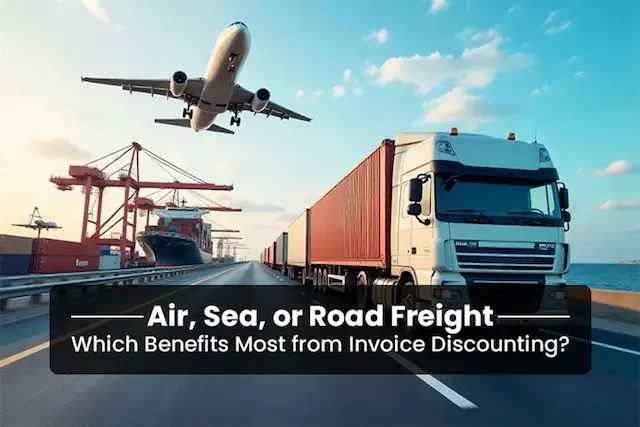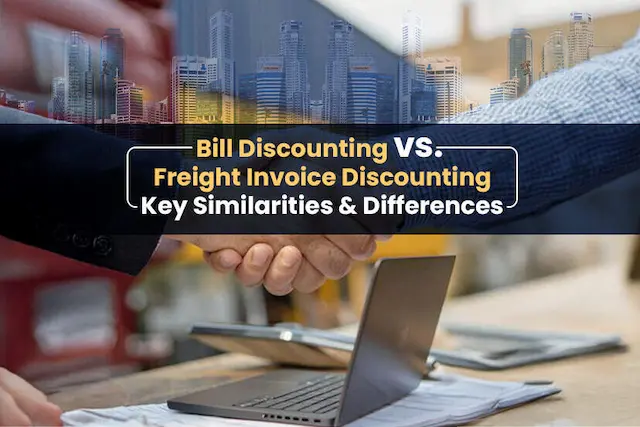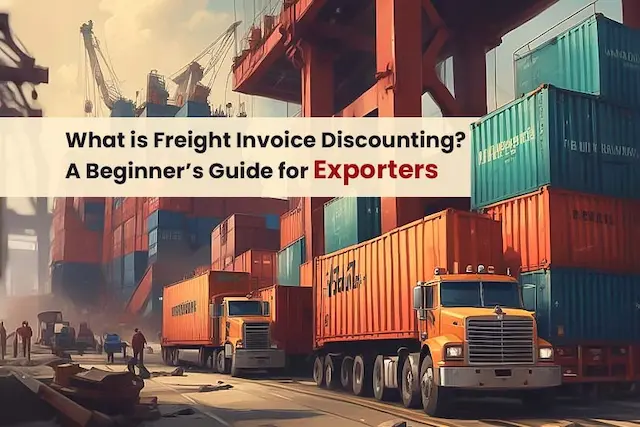Waiting for customers to pay invoices to avoid cash strain in business? Get into the details of what is invoice discounting in business here!
Mr. Vinay is a reputable manufacturer of solar panels. He successfully completed a big order recently for one government office. As per the payment terms they agreed on mutually, Mr. Vinay will receive the payment after three months.
Shortly after, he got another big order, but this time he didn’t have enough money to buy the raw materials needed to complete the order. He is sure to get the payment from the first order he fulfilled, but he will have to let go of the second offer he cannot fulfill on time. This is where the question ‘what is invoice discounting’ and its proper knowledge can help him clear the obascale and fulfill the order on time.
Here in this article, we will try to cover many aspects of the topic, from what is invoice discounting, its definition & how invoice discounting works to more that you should know in case you want a practice like invoice discounting to help you financially.
What is Invoice Discounting?
Invoice discounting, also called Bill Discounting, is issued by a financial institution where a company uses its unpaid invoices as collateral for loans. It’s a short-term practice of borrowing money, and a very effective finance solution as a business can receive advance money for uninterrupted cash flow leading to growth.
The amount of debt issued by the financial firm is less than the total amount of outstanding receivables (usually 80% of all invoices, 90% in case of Credlix, less than 90 days old).
How Does Invoice Discounting Work?
Invoice discounting works as follows:
A firm sells its goods & services to its client.
The firm then shares an invoice with the client with a deadline to make the payment, which could be up to three months.
Now, the firm forwards the same invoice to a third-party, which is mostly a financing company.
The finance company to which the invoice is transferred purchases the firm’s or business’s accounts receivable.
Now, when the client to whom the goods and services were sold pays back, the balance of the invoice is given back to the firm after deducting the service fee.
Types Of Invoice Discounting
There are different types of invoice discounting for a business to choose from. Have a look at what is invoice discounting in banking and its other types.
Confidential Invoice Discounting
Confidential invoice discounting is similar to standard invoice discounting. The difference is that this form of invoice discounting is more of a private arrangement where the customers with unpaid invoices are unaware of it.
Selective Invoice Discounting
Selective invoice discounting is also the same as standard invoice discounting. It gives businesses more control over the invoices they sell to lenders in exchange for advances. Businesses choose to select unpaid invoices to sell rather than presenting a whole sales ledger of overdue invoices. Selective invoice financing must be used to handle invoice collections.
Invoice Factoring
Also known as business factoring, invoice factoring is also one of the types that includes “selling” the invoices to a lender. Once the invoices have been sold, the company now owns the unpaid invoices and has the responsibility to collect the amount from the customer.
Process of Invoice Discounting
Invoice discounting comprises the following steps. It’s a relatively easier process:
1. Choose The Right Financing Partner
As a receiver, you have many options to choose the right invoice discounting partner, like banks, special lending institutions, and online platforms, which are also popular options now.
2. Submit Your Invoices
Once you know what provider to go with, you will be asked to submit your unpaid invoices for review. The provider will verify whether the invoices submitted are legitimate and the order has been successfully fulfilled.
3. Wait for the Payment
After your invoice has been successfully reviewed and verified, you are eligible to receive your amount, which is 70–90% of the total invoice value, depending on the provider’s policies.
4. Receive the Payment
Now your provider is responsible for collecting the money from your customer. On the other hand, you get your money against your invoice, which is minus the discount fee that the provider will charge you for the early payment.
7 Prominent Advantages of Invoice Discounting
Are you wondering if is invoice discounting is a good idea? Invoice discounting has multiple advantages provided by even the most prominent financial institutions like banks and NBFCs. Have a look at them one by one:
1. Quick Money
Banks and other lending institutions provide fast cash through invoice discounting. In fact, it’s a comparatively easier and more convenient way than loans, with fast disbursal of short-term lending using unpaid invoices as your simple collateral. You meet your working capital requirements with a quick infusion of cash.
2. Improved Cash Flow
The process of invoice discounting is specifically designed and streamlined for fast cash followed by improved working capital, secured money, cash flow, and keeping the business running. It’s much better than a business loan.
3. Unlock The Cash Stuck
Invoice discounting frees up cash that has become locked in a company’s supply chain. An invoice finance company lends money on the basis of valid customer invoices, converting accounts receivable into quick cash.
4. No Collateral
Invoice discounting doesn’t involve anything in the form of collateral or guarantor. The lending platform won’t ask for any kind of collateral other than your commercial invoices ready to avail of quick cash.
5. Total Control
Unlike invoice factoring, invoice discounting providers do not take over a company’s sales ledger and begin collecting payments for accounts receivable. Businesses are free to keep their activites a secret from their clients.
6. Growth of Credit Sales
Invoice discounting converts said credit into liquid cash. The growth of credit sales is one of the major advantages of invoice discounting. When companies know they have access to easy and quick money, they grow confident and continue with their business activities with partners who are ready to redefine their financing. Such credit fuels their growth.
7. Fast Payments
Invoice discounting helps firms avoid cash flow interruptions and meet payback commitments more quickly. A positive cash flow might also qualify a company for several loan programmes.
Disadvantages of Invoice Discounting
Like everything under the sun, invoice discounting too has some disadvantages with advantages. Here are some drawbacks to take into account:
1. Lesser Profits
Due to the commission charged by the lending institutions, the profit margin gets affected. But there are still lending platforms like Credlix that charge less and provide 90% of the invoice amount, which cuts the loss.
2. Consider Your Finances
You must also consider that getting frequent loans based on invoices can damage your reputation with clients and suppliers. Also, if you have to borrow money against your customer’s invoices frequently, you must reconsider and improve your payment cycle, cash flow, and working capital.
3. Commercial Invoices
Even invoice discounting is sometimes considered an unsecured business loan. Also, these discounting companies only provide money against commercial invoices with wholesale, dealers, suppliers, and vendors. For the companies dealing with the general public, it could be a problem.
4. Volatility
The volatility of invoice financing originates from the fact that a company can only get short-term financing based on the number of outstanding sales invoices. As a result, such funds may run out rapidly and be insufficient to carry out any major financial activities.
To effectively utilize invoice discounting, it’s very critical that clients and buyers pay on time. Clients failing to pay on time may make things volatile.
Difference Between Invoice Discounting and Factoring
What is invoice factoring? Invoice factoring, also referred to as accounts receivable factoring, is a financial transaction where a company “sells” its outstanding invoices to a third-party financing company, known as a factoring company, at a discounted price in exchange for immediate cash. The lending firm then holds the responsibility of collecting the debts from the customers of the company that issued the invoices.
Both invoice discounting and factoring are financial facilities that release the capital stuck in your unpaid invoices. As a result, the supplier decides to issue a cash advance in the face of overdue debtor balances.
Factoring is mostly applied by startups or smaller businesses. On the other hand, invoice discounting is applied by reputable businesses.
The main difference between the two lies in the area of who controls the sales ledger and who is accountable for getting payment. For more clarity, keep reading!
In the case of invoice factoring, the provider holds the responsibility for the sales ledger, credit control, and running after customers to settle the invoice.
With invoice discounting, control of the sales ledger and settling the payment remain in the receiver’s hands.
Confidentiality is another factor that differentiates these two.
In the case of factoring, the customers have to deal with the factoring company for the payment settlement. Therefore, they become aware and conscious of your factoring plan.
In the case of invoice discounting, no third party is involved for the payment settlement.
Credit Risk and Mitigation in Invoice Discounting
Credit risk has always been a factor considered in invoice discounting. Why? As someone who is receiving invoice discounting, you are the one lending your receivables to a financial institution at a discount. In fact, the receiver is also at credit risk because the lender is taking the risk of the debts being repaid or not.
Mitigating this risk is vital so the party receiving can successfully maintain their cash flow to overcome financial hurdles.
One of the ways is to sell your credit to a reputable company with a strong history and success rate after intensive research (consider the tips mentioned in this article).
Another way to mitigate credit risk is to include provisions in the agreement that the finance lender must provide a notice before taking any legal action against the customers whose invoices are being sold.
Finally, by diversifying their customer base, the receiver can reduce credit risk. The receiver can spread their risk across several consumers by selling invoices to multiple organizations, lowering the impact of any single default.
Tips for Choosing a Reliable Invoice Discounting Provider
It’s always a challenge to choose a reliable invoice discounting lending partner, but here are some tips that will definitely help you make an informed decision:
1. Experience and Reputation
Experience and reputation are two things with which to start your hunt for the best financing partner that can offer the best terms against your sales credit. Look for reviews, feedback, previous clients, ratings, and history. The longer the platform is in the marketplace, the more experience and expertise it has. The more expertise there is, the better it will handle your unique needs.
2. Flexibility
When looking for an invoice discounting partner, flexibility is a must so it can accommodate and adjust as per the cash flow complexities and needs you have. The lending platform should be open enough to formulate a finance plan that fits your business needs.
3. Fees
Examine the prices that different invoice discounting companies charge. Certain suppliers may offer hidden costs, so carefully read the tiny print.
4. Customer Service
Always choose a landing partner that offers quick customer care services. They should be active in responding to your queries and providing quick support for any problem you face.
5. Security
Check to see if the invoice discounting company has enough security procedures in place to protect your sensitive financial information.
Industries Benefited From Invoice Discounting
Here are some of the most popular sectors that are benefited the most by invoice discounting:
Manufacturing
Manufacturing is one of the industries with multiple financial requirements. For example, there could be incidents where machines need repairing as well as maintenance. The company needs funds in both cases. Moreover, manufacturing industries have employees with salaries and other overhead expenses. Therefore, this industry benefits the most from invoice discounting to overcome cash-flow problems.
Printing & Publishing
The printing and publishing industries grow conveniently with the help of invoice discounting. They don’t have to wait longer for clients to clear the payments, which facilitates businesses taking on new projects conveniently.
Construction
Payments are often delayed in the construction industry, which is a major cash flow issue. This cash flow disruption can bottleneck growth and flow. With invoice discounting, these firms get the freedom to take up future projects and complete them more quickly and efficiently.
Final Words
Was the above article helpful in clearing the air around you as to what is invoice discounting, what is the process, its types, advantages, disadvantages, and everything else? Well, get immediate financial help through invoice discounting to keep the good cash flow running to fulfill your orders and increase your ROI.
Make sure to always choose the right lending partner and the right invoice discounting in business through the tips mentioned above.
We Can Help!
Get up to 90% of your invoice value in working capital right away with Credlix. We are a popular invoice discounting platform in India where you can get speedier cash for your export bills with less paperwork and no hard collateral. We charge a pre-agreed fee, typically 1-3% of the loan. The Buyer pays the invoice within the agreed period.
We make it easier for businesses to apply for funding and manage their invoices.
FAQs
1. Who can avail Invoice Discounting?
The facility of invoice discounting is available to all businesses who serve the clients and customers with goods and services. Still the key players would be manufacturers, distributors, B2B services, etc.
2. Is any security required if I take Invoice Finance with Credlix?
No, invoice discounting with Credlix doesn’t require any security or collateral. Credlix is a supply chain finance company that provides quick and collateral-free working capital solutions to businesses.
3. What is the difference between Factoring and Invoice Finance?
Invoice factoring is a financial transaction where a company “sells” its outstanding invoices to a third-party financing company, known as a factoring company, at a discounted price in exchange for immediate cash.
Invoice financing is the process of borrowing money against an account’s outstanding receivables. A lender delivers a lump sum of money up front as a loan or credit in invoice financing.
4. What are the advantages of Invoice Discounting?
Invoice discounting has multiple advantages:
Quick money
Improved cash flow
No collateral
Fast payments
Unlock the cash stuck
Protection from bad debts
5. How much loan capital can be availed through Invoice Discounting?
The loan capital that can be availed of through Invoice Discounting mainly depends on the user’s financial requirements, needs, credit assessment, etc. Depending on these factors, the financial institution grants loans of up to 90% of the total value of the invoice.




